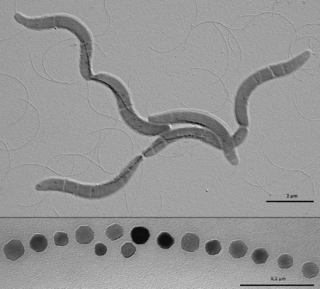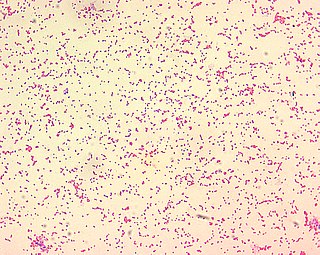
Enterobacteriaceae is a large family of Gram-negative bacteria. It includes over 30 genera and more than 100 species. Its classification above the level of family is still a subject of debate, but one classification places it in the order Enterobacterales of the class Gammaproteobacteria in the phylum Pseudomonadota. In 2016, the description and members of this family were emended based on comparative genomic analyses by Adeolu et al.

The Rhodospirillales are an order of Pseudomonadota.

The Chlamydiota are a bacterial phylum and class whose members are remarkably diverse, including pathogens of humans and animals, symbionts of ubiquitous protozoa, and marine sediment forms not yet well understood. All of the Chlamydiota that humans have known about for many decades are obligate intracellular bacteria; in 2020 many additional Chlamydiota were discovered in ocean-floor environments, and it is not yet known whether they all have hosts. Historically it was believed that all Chlamydiota had a peptidoglycan-free cell wall, but studies in the 2010s demonstrated a detectable presence of peptidoglycan, as well as other important proteins.

Enterobacterales is an order of Gram-negative, non-spore forming, facultatively anaerobic, rod-shaped bacteria with the class Gammaproteobacteria. The type genus of this order is Enterobacter.

The Nitrosomonadales are an order of the class Betaproteobacteria in the phylum "Pseudomonadota". Like all members of their class, they are Gram-negative.
The Rhodocyclaceae are a family of gram-negative bacteria. They are given their own order in the beta subgroup of Pseudomonadota, and include many genera previously assigned to the family Pseudomonadaceae.

The Brucellaceae are a family of the Gram-negative Hyphomicrobiales. They are named after Sir David Bruce, a Scottish microbiologist. They are aerobic chemoorganotrophes. The family comprises pathogen and soil bacteria

Desulfovibrionales are a taxonomic order of bacteria belonging to the phylum Thermodesulfobacteriota, with four families. They are Gram-negative. The majority are sulfate-reducing, with the exception of Lawsonia and Bilophila. All members of this order are obligately anaerobic. Most species are mesophilic, but some are moderate thermophiles.
The Syntrophobacterales are an order of Thermodesulfobacteriota. All genera are strictly anaerobic. Many of the family Syntrophobacteraceae are sulfate-reducing. Some species are motile by using one polar flagellum.

The Burkholderiaceae are a family of bacteria included in the order Burkholderiales. It includes some pathogenic species, such as Burkholderia mallei (glanders) and Burkholderia pseudomallei (melioidosis). This family was found to be enriched in scale-eating pupfish guts, even after being fed a common laboratory diet, suggesting it may aid in scale-digestion.

Porphyromonadaceae is a family of Gram-negative bacteria described by Noel R. Krieg in 2015. It contains nine genera, five of which are validly published by the International Code of Nomenclature of Prokaryotes. Bacteria with 16S ribosomal RNA highly similar to the Porphyromonas genus, as compared to the larger taxonomic order Bacteroidales, are classified in this family.

Comamonas is a genus of bacteria in the phylum Pseudomonadota. Like all Pseudomonadota, they are Gram-negative bacteria. Comamonas species are aerobic organisms and motile using bipolar or polar tufts of one to five flagella. Comamonas testosteroni and Comamonas kerstersii have been found to cause infections in people.
Aminobacter aminovorans is a Gram-negative soil bacteria.
Methylobacillus is a genus of Gram-negative methylotrophic bacteria. The cells are rod-shaped.
Bergey's Manual of Systematic Bacteriology is the main resource for determining the identity of prokaryotic organisms, emphasizing bacterial species, using every characterizing aspect.
Pelobacter is a bacterial genus in the order Desulfuromonadales. The cells are rod-shaped with rounded ends and occur in single, pairs or chains. They have a fermentative metabolism.
Spirillum winogradskyi is a gram-negative, bacterium from the genus of Spirillum which was isolated from the sulfidic sludge of a municipal wastewater treatment plant.
The Marinilabiliaceae are a family of bacteria.

Aquaspirillum /ˌakwəspəˈrɪləm/ is a genus of helical aerobic bacteria in the family Neisseriaceae that lives in freshwater.
Azospirillum lipoferum is a species of microaerophilic, gram-negative, rod-shaped, nitrogen-fixing bacteria. They are currently most notable for the ability to enhance the success of certain agricultural plant products such as maize, rice, and wheat.










